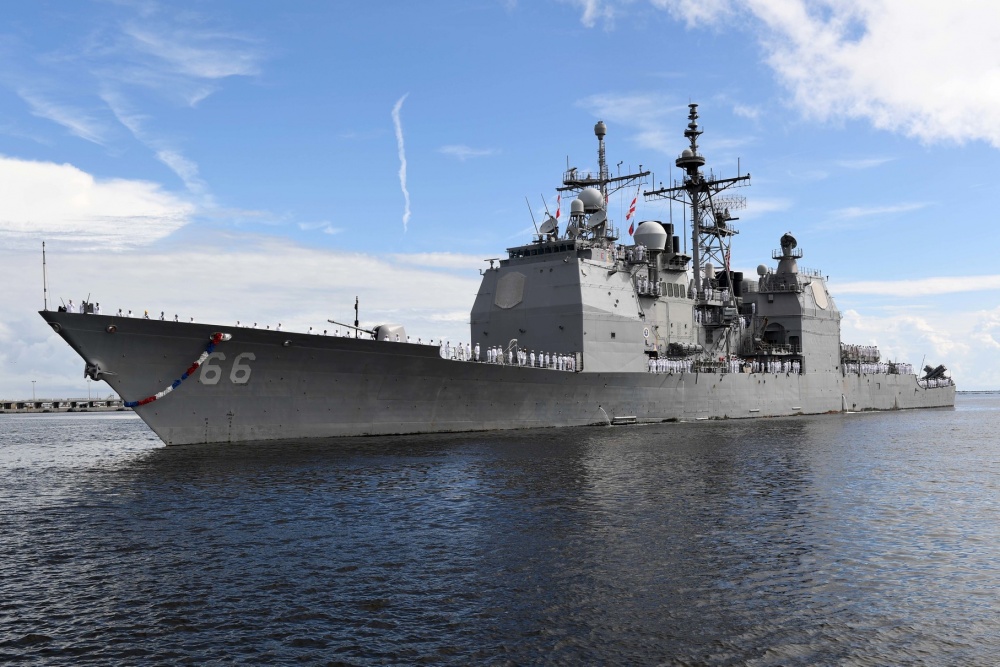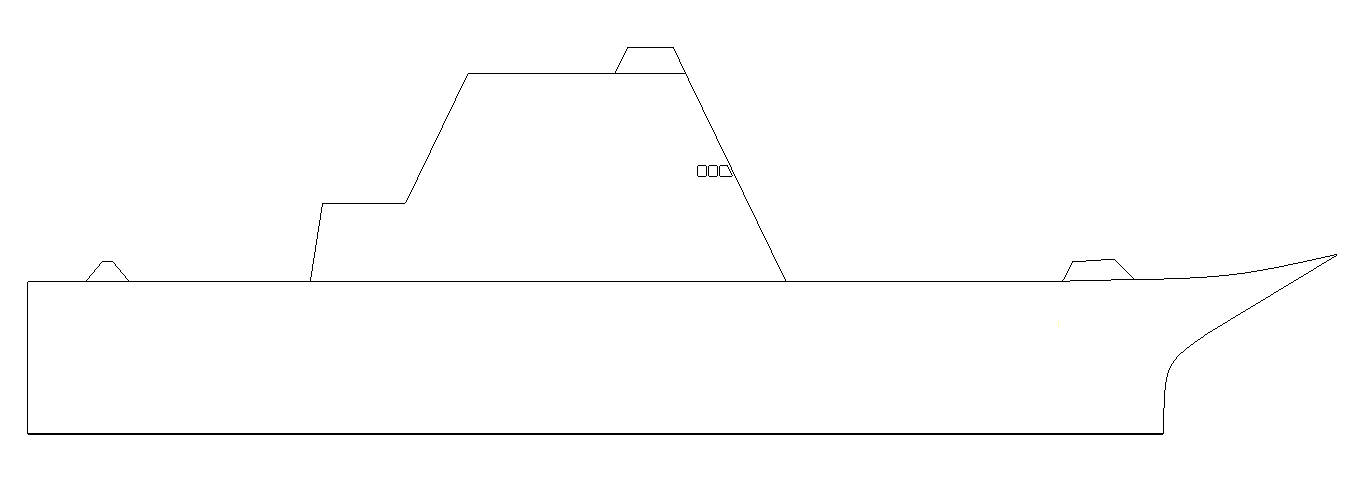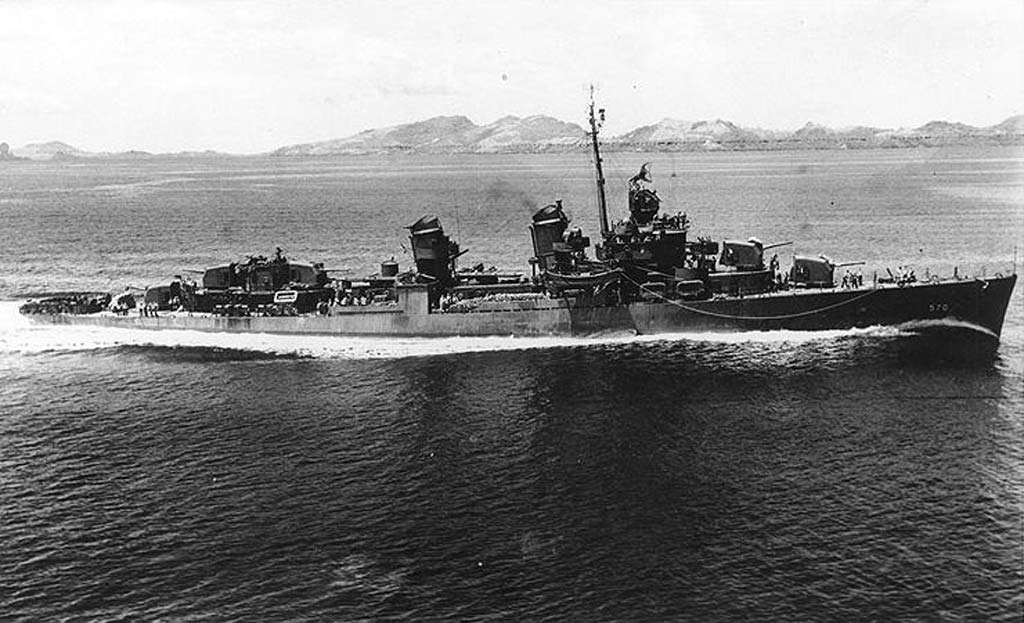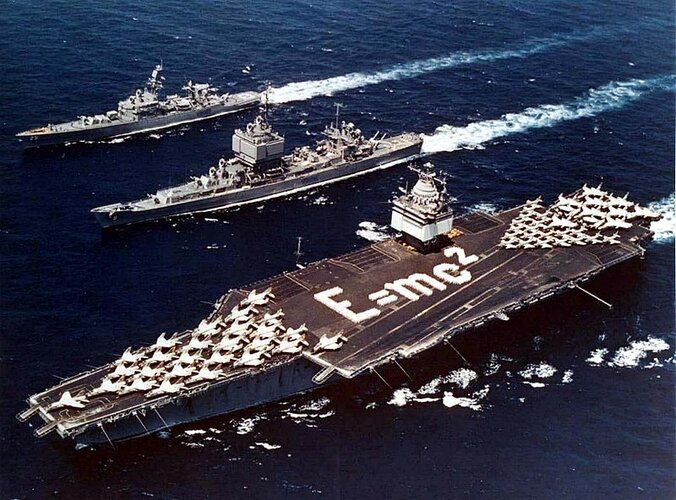You are using an out of date browser. It may not display this or other websites correctly.
You should upgrade or use an alternative browser.
You should upgrade or use an alternative browser.
CG(X) Air-Dominance Cruiser
- Thread starter Triton
- Start date
Racer said:Really? Same joke as in 2009? ;D (refer to last on page 2)
It needs eyes painted on the bow too.
- Joined
- 18 March 2008
- Messages
- 3,529
- Reaction score
- 983
Racer said:Really? Same joke as in 2009? ;D (refer to last on page 2)
I'm looking forward to reading it again in 2019!
- Joined
- 4 July 2010
- Messages
- 2,515
- Reaction score
- 3,094
There's a bunch of these. Haven't updated since 2010 unfortunately. Would be really interested to know if their current projects are aimed at FSC at all.donnage99 said:
- Joined
- 4 July 2010
- Messages
- 2,515
- Reaction score
- 3,094
Depends how far back you want to go for "original," but the general intent for CG(X) was to have a class start to hit the water in the 2018-2020 timeframe.bobbymike said:https://www.defensenews.com/naval/2017/10/09/the-us-navy-will-start-losing-its-largest-surface-combatants-in-2020/
So what was the original timeline for CG(X) deployment?
- Joined
- 3 June 2011
- Messages
- 18,338
- Reaction score
- 12,240
Moose said:Depends how far back you want to go for "original," but the general intent for CG(X) was to have a class start to hit the water in the 2018-2020 timeframe.bobbymike said:https://www.defensenews.com/naval/2017/10/09/the-us-navy-will-start-losing-its-largest-surface-combatants-in-2020/
So what was the original timeline for CG(X) deployment?
The only viable way forward, that won't take decades, is to go with their original plan and do a CG version of the Zumwalt. A Burke III won't hack it.
- Joined
- 9 October 2009
- Messages
- 21,976
- Reaction score
- 13,636
https://www.defensenews.com/naval/2018/09/17/the-us-navy-is-going-to-need-a-bigger-boat-and-its-getting-ready-to-buy-one/
http://cdrsalamander.blogspot.com/2018/09/large-surface-combatant-act-1-what.html
http://cdrsalamander.blogspot.com/2018/09/large-surface-combatant-act-1-what.html
- Joined
- 4 July 2010
- Messages
- 2,515
- Reaction score
- 3,094
I would not assume the "N" at this time. The cost premium for a reactor is still a lot to ask, and it would require a significant "push" the likes of which I'm not confident today's Navy is capable of. Without a breakthrough cost reduction measure or someone powerfully placed in Congress making it their baby, I'm just plain skeptical. More likely in my estimation would be a return to one of the envisioned DD-21 power architectures before the program was reorganized in 2001: 4 big turbines and PMM.Tzoli said:So CG(N)(X) V2.0?
- Joined
- 21 April 2009
- Messages
- 13,758
- Reaction score
- 7,697

Cruiser CG-66 Enters Modernization Program - Defense Daily
The guided-missile cruiser USS Hué City (CG-66) entered the Cruiser Modernization program at Norfolk Naval Base on Sept. 30, the Navy said Friday.
 www.defensedaily.com
www.defensedaily.com
So, I have a discord buddy who works at Newport News. Apparently, Newport News' final concept for CG(X) before the program was canceled is a ~20000 ton nuclear cruiser based on the Worcester hullform.

Basic above-waterline profile of the concept, they chopped Worcester's stern to a transom so they could add a towed array, and added a sharper flare to the upper bow for better seakeeping as the design is heavier than CL-144. CG(X) targeted a displacement of 20000 tons or less for affordability, so Worcester's hull was the closest basis in terms of displacement and stability characteristics.
Long story short, although Des Moines is closer in displacement, this ship is nuclear-powered, and thus has a lower center of gravity than DM would, therefore the DM hull has excessive stability.
TLDR: basically a ~20k ton Worcester with big bow flare, transom stern, and Zumwalt superstructure. No idea on weaponry or other characteristics, trying to get more info

Basic above-waterline profile of the concept, they chopped Worcester's stern to a transom so they could add a towed array, and added a sharper flare to the upper bow for better seakeeping as the design is heavier than CL-144. CG(X) targeted a displacement of 20000 tons or less for affordability, so Worcester's hull was the closest basis in terms of displacement and stability characteristics.
Long story short, although Des Moines is closer in displacement, this ship is nuclear-powered, and thus has a lower center of gravity than DM would, therefore the DM hull has excessive stability.
TLDR: basically a ~20k ton Worcester with big bow flare, transom stern, and Zumwalt superstructure. No idea on weaponry or other characteristics, trying to get more info
that_person
ACCESS: Secret
- Joined
- 25 May 2021
- Messages
- 339
- Reaction score
- 650
I thought CG(X) was entirely handled by NAVSEA?
- Joined
- 1 February 2011
- Messages
- 2,939
- Reaction score
- 3,624
Do we know more about the 2006 Medium Surface Combatant Variants?
The 2008 paper shared previously in this thread ( The CGBL – a Product Improved Version of the CG 52 ) showing the Plug and Slide modification of the first 4 Ticonderogas which describe only one, the MFM-1 ( Medium size, Fossil fuel, Mechanical drive) with only limited info:
219,76 (wl) x 25m 21.260tons (long)
Twin island hull, very high power radar
1x 155mm gun and 157x VLS
The 2008 paper shared previously in this thread ( The CGBL – a Product Improved Version of the CG 52 ) showing the Plug and Slide modification of the first 4 Ticonderogas which describe only one, the MFM-1 ( Medium size, Fossil fuel, Mechanical drive) with only limited info:
219,76 (wl) x 25m 21.260tons (long)
Twin island hull, very high power radar
1x 155mm gun and 157x VLS
Attachments
- Joined
- 1 February 2011
- Messages
- 2,939
- Reaction score
- 3,624
Maybe I should search google first? Though often such designs were not found by the engine.
This document seems to provide some extent on the Small/Medium/Amphibious Surface Combatant studies at least regarding the propulsion:

 kipdf.com
kipdf.com
This document seems to provide some extent on the Small/Medium/Amphibious Surface Combatant studies at least regarding the propulsion:

Alternative Propulsion Methods for Surface Combatants and Amphibious Warfare Ships - KIPDF.COM
Alternative Propulsion Methods for Surface Combatants and Amphibious Warfare Ships James S. Webster, Visitor, Naval Sea ...
- Joined
- 16 April 2008
- Messages
- 9,606
- Reaction score
- 14,502
Do we know more about the 2006 Medium Surface Combatant Variants?
The 2008 paper shared previously in this thread ( The CGBL – a Product Improved Version of the CG 52 ) showing the Plug and Slide modification of the first 4 Ticonderogas which describe only one, the MFM-1 ( Medium size, Fossil fuel, Mechanical drive) with only limited info:
219,76 (wl) x 25m 21.260tons (long)
Twin island hull, very high power radar
1x 155mm gun and 157x VLS
They were a series of models based around the same payload, with alternative propulsion arrangements. MFM-1 was their first cut, then they iterated the power plant (GODOG vs COGOG, IPS vs Mechanical drivetrain, nuclear, etc.) It looks like they held length and hullform constant, so the only real variation is draft, waterline beam (for the deeper versions) and speed.
The main purpose was to look at the comparative cost of fossil fuel vs nuclear -- from their analysis, the break even cost of fuel is nearly $200 per barrel for the small combatant, and at least $70 (more like $115 plus) for the medium combatant. So, a very hard economic case for nuke power on modern frigates and a somewhat better, but still hard, on modern cruisers.
Attachments
Last edited:
- Joined
- 1 February 2011
- Messages
- 2,939
- Reaction score
- 3,624
I see. I've yet to fully read the article, but is there a mention what kind of reactor these proposals should use? The older D2G or a nominal new Destroyer/Cruiser Reactor or a smaller scale A1B of the Ford class?
- Joined
- 16 April 2008
- Messages
- 9,606
- Reaction score
- 14,502
They don't call out specific plants (likely for reasons of classification). For the small ship, it's a "modified existing submarine class propulsion plant." For the medium, it's "one modified next generation aircraft carrier propulsion plant."
alexander368
ACCESS: Restricted
- Joined
- 12 May 2022
- Messages
- 2
- Reaction score
- 10
Found this design from HII at SAS 2017 while browsing old naval expo reports. Named the "Future Surface Combatant", it is marketed as a replacement to the Ticos and to fulfill their BMD and fleet air defense role. It is fitted with the maximum size variant of the AN/SPY-6 with a 35 ft array along with 96 VLS cells for very long range interception. Based on the proven LPD-17 hull form, it has a large room for upgrades but is consequently much heavier and slower than the Ticos at an estimated 27000t with a top speed of 20+ knots.
Seems to me good for carrier protection with such an impressive radar and missile capacity, but speed may affect its ability to keep up with a CSG.

Seems to me good for carrier protection with such an impressive radar and missile capacity, but speed may affect its ability to keep up with a CSG.
that_person
ACCESS: Secret
- Joined
- 25 May 2021
- Messages
- 339
- Reaction score
- 650
Did some digging into the CG(X) program today, found some interesting stuff. First, the name of the official Analysis of Alternatives (AoA), which reported back in August of 2007, was called the "Maritime Air and Missile Defense of Joint Forces (MAMDJF) AoA". Unfortunately, while I wasn't able to find the study itself, references to it tell us that it encompassed several ideas and concepts, including but certainly not limited to:
"MAMDJF AOA considered a wide range of ship variants, including a new cruiser concept, a new radar ship concept, modified and upgraded DDG 1000 variants, a modified DDG 51 variant with a 40' hull extension (known as a plug), and a modified LPD 17 amphibious transport dock ship variant. IAMD is the simultaneous defense against both ballistic missile threat and air warfare threats such as hostile aircraft and cruise missiles. Some CG 47s and DDG 51s can perform air warfare and BMD, the Oliver Hazard Perry class frigates (FFG 7) can only conduct short range anti-air warfare and no ballistic missile defense."
This sounds a lot like some of the SC-21 Concept 2 studies Friedman mentioned. While I was not able to locate the actual study itself, multiple references to it say that both the AMDR and CG(X) programs evolved out of this AoA, and that the AMDR (which turned into the SPY-6 and 7), was to be mounted on the CG(X), not the Dual-Band Radar (DBR, SPY-3 and 4).
I also think I may of found the original mention of the Burke Flight IV concept, although it doesn't say anything of any note. Only that "we may end up doing another Burke in the early 2030s. We don't have any details."
On top of this, apparently, the USN never ruled on if they wanted CG(X) to be nuclear or conventionally powered.
Sources
"MAMDJF AOA considered a wide range of ship variants, including a new cruiser concept, a new radar ship concept, modified and upgraded DDG 1000 variants, a modified DDG 51 variant with a 40' hull extension (known as a plug), and a modified LPD 17 amphibious transport dock ship variant. IAMD is the simultaneous defense against both ballistic missile threat and air warfare threats such as hostile aircraft and cruise missiles. Some CG 47s and DDG 51s can perform air warfare and BMD, the Oliver Hazard Perry class frigates (FFG 7) can only conduct short range anti-air warfare and no ballistic missile defense."
This sounds a lot like some of the SC-21 Concept 2 studies Friedman mentioned. While I was not able to locate the actual study itself, multiple references to it say that both the AMDR and CG(X) programs evolved out of this AoA, and that the AMDR (which turned into the SPY-6 and 7), was to be mounted on the CG(X), not the Dual-Band Radar (DBR, SPY-3 and 4).
I also think I may of found the original mention of the Burke Flight IV concept, although it doesn't say anything of any note. Only that "we may end up doing another Burke in the early 2030s. We don't have any details."
On top of this, apparently, the USN never ruled on if they wanted CG(X) to be nuclear or conventionally powered.
Sources
Last edited:
Kat Tsun
eeeeeeeeeeeeeee
- Joined
- 16 June 2013
- Messages
- 1,371
- Reaction score
- 1,778
Found this design from HII at SAS 2017 while browsing old naval expo reports. Named the "Future Surface Combatant", it is marketed as a replacement to the Ticos and to fulfill their BMD and fleet air defense role. It is fitted with the maximum size variant of the AN/SPY-6 with a 35 ft array along with 96 VLS cells for very long range interception. Based on the proven LPD-17 hull form, it has a large room for upgrades but is consequently much heavier and slower than the Ticos at an estimated 27000t with a top speed of 20+ knots.
Seems to me good for carrier protection with such an impressive radar and missile capacity, but speed may affect its ability to keep up with a CSG.
A US CVBG only has conventional escorts so I it won't affect the tactical speed of the group. The only thing that can sustain 30+ knots in any weather that isn't perfectly calm is the carrier itself. Burkes and Ticos are the reason carriers get stuck going ~20 knots +/- 2 knots in almost all cases. Eking out a top end of 28 or 25 or whatever knots vice ~30 isn't a big deal when dealing with the threat of long range ballistic missiles and supersonic attack bombers.
This seems to be the ideal US BMD ship in general as it's a hullform which is already programmed in for LSD(R) and, assuming the Congress decides to fund anything besides Flt IIIs, will probably end up doing what CG(X) was supposed to do.
LPDs being fairly muscular and relatively long legged, at least when compared to Burkes, they are not going to be the actual bottleneck in battlegroup transit speeds. They won't be sprinting of course, but neither will a battlegroup as a whole, although escorts will sprint individually. LPDs can sustain 20 knots ordinarily. The honor of "slowest lad" I think will go to the Constellations in all likelihood, much as the Perries were the weak link in the 1980's BATGRUs, because it's a tiny frigate and frigates are notoriously bad at maintaining anything more than about 15-16 knot cruise speeds.
Carriers outrunning their escorts is a perennial problem of mixing propulsion types though, which is why a nuclear surface escort is theoretically needed. In practice, the BATGRU just draws a fat circle around a combat zone, puts an X on the safety line, and the carrier zips over there and dawdles for a bit with a 4-ship CAP while the rest of the BATGRU catches up. One escort ship, al a Bainbridge and Kitty Hawk steaming 30 knots in a hurricane, isn't a huge deal to anyone who seriously wants to trouble the carrier anyway.
Provided there's a squadron or two of F-35C on the ship for CAP, and an E-2D coordinating the air battle, the carrier will be fine for the three or four hours it takes the rest of the battlegroup to resume formation. The first thing on the threat axis in a combat zone will be a Burke (or Constellation) anyway.
To have any meaningful effect on the tactical speed of the battlegroup would require nuclear everything. Nuclear cruisers, destroyers, frigates, and supply ships, to accompany the nuclear carrier. This is impossible within any realistic resource allocations, of course, so it's a bit silly to complain about.
Last edited:
- Joined
- 16 April 2008
- Messages
- 9,606
- Reaction score
- 14,502
The honor of "slowest lad" I think will go to the Constellations in all likelihood, much as the Perries were the weak link in the 1980's BATGRUs, because it's a tiny frigate and frigates are notoriously bad at maintaining anything more than about 15-16 knot cruise speeds.
The Constellation class aren't your grandfather's frigates. At 7300 tons fl and almost 500 feet long, they'll be fine. They won't be blisteringly fast, for the same reason you point out -- they don't need to be. And then again, neither do the DDGs. They've never been speed demons. Do you know how hard they fought (and essentially over-drove the ship) to get the lead ship to 31 knots just so they could make an allusion to 31-Knot Burke. (Which is pretty ironic considering that 31-knots was slow, in the original context)
But, there have been cases where a nuke carrier dragged one or two of her escorts along at 25+ knots sustained for an urgent redeployment, relying on quick CVN-CG UNREPs to top them off at the other end. At least some BMD-capable task force escorts need to be able to move out like that.
Last edited:
Firefinder
ACCESS: Top Secret
- Joined
- 5 October 2019
- Messages
- 1,049
- Reaction score
- 1,901
Actually it was pretty fast.(Which is pretty ironic considering that 31-knots was slow, in the original context
Cause the way that Arliegh Burke got the 31 knot taunt was because when he was asked what the fuck he was doing in a Japanese minefield he answer was...
"Doing 31 knots sir."
Which is stupid fast to be doing in minefield period unless you know the safe routes, even then it pushing it.
- Joined
- 16 April 2008
- Messages
- 9,606
- Reaction score
- 14,502
Actually it was pretty fast.(Which is pretty ironic considering that 31-knots was slow, in the original context
Cause the way that Arliegh Burke got the 31 knot taunt was because when he was asked what the fuck he was doing in a Japanese minefield he answer was...
"Doing 31 knots sir."
Which is stupid fast to be doing in minefield period unless you know the safe routes, even then it pushing it.
Nope. There are a couple of variations on the story, but they all depend on the fact that Burke's squadron was suffering from deferred maintenance and was unable to sustain their expected top speed. What they could manage was 31 knots, which drew a little jibe from Halsey (or his staff).
https://arleighburkeassociation.org/burke-top/burke-bio-ext/
The ships of the time were capable of 34 knots, but while enroute to a rendezvous prior to that battle, a boiler casualty had limited his group’s top speed to 30 knots. When the fleet commander signalled him to make best speed, they mustered an extra knot and he answered “Proceeding at 31 knots” The response, addressed to “31-knot” Burke was a “rib”, but captured the imagination of the press and the public and conveyed the image of a dashing, hard-charging combat commander – an accurate description of Arleigh Burke.

“31-Knot” Burke Gets His Nickname: The Battle of Cape St. George | Defense Media Network
A history of the Battle of Cape St. George, a World War II naval battle where then-Capt. Arleigh Burke received his nickname.www.defensemedianetwork.com
Burke was new to the command, having assumed it on October 23. He received his orders while his ships were refueling at New Georgia Island, approximately 300 miles southeast. Burke was told to top off his ships’ bunkers and proceed with all due speed to the intercept point “Point Uncle.” The Fletcher-class destroyers of DESRON 23 (Charles Ausburne (flag), Claxton, Dyson, Converse, and Spence) had been in constant action since September, and were overdue for maintenance. As a result, Burke knew his ships were incapable of reaching their top rated speed of 38 knots. Accounts vary regarding Burke’s message to Halsey on that subject, with some claiming he sent a message before proceeding to Point Uncle, others after, and variations of the speed itself. Most accounts state his slowest ship was the Spence, capable of 31 knots. That was the speed referenced when Burke sent his message to Halsey. Regardless, it was Halsey’s response that gave Burke his famous nickname:
(Note: 38 knots is nonsense -- Fletchers could never do 38 knots even on their best day. Their trials speed was 36.5, making an expectation of 34 in operations more plausible.)
But no matter what version you buy, it's Halsey's slightly joking reply that created the nickname:
THIRTY-ONE KNOT BURKE GET ATHWART THE BUKA-RABAUL EVACUATION LINE ABOUT 35 MILES WEST OF BUKA XXX IF NO ENEMY CONTACTS BY 0300 . . . 25TH . . . COME SOUTH TO REFUEL SAME PLACE XXX IF ENEMY CONTACTED YOU KNOW WHAT TO DO
Kat Tsun
eeeeeeeeeeeeeee
- Joined
- 16 June 2013
- Messages
- 1,371
- Reaction score
- 1,778
The honor of "slowest lad" I think will go to the Constellations in all likelihood, much as the Perries were the weak link in the 1980's BATGRUs, because it's a tiny frigate and frigates are notoriously bad at maintaining anything more than about 15-16 knot cruise speeds.
The Constellation class aren't your grandfather's frigates. At 7300 tons fl and almost 500 feet long, they'll be fine. They won't be blisteringly fast, for the same reason you point out -- they don't need to be. And then again, neither do the DDGs. They've never been speed demons. Do you know how hard they fought (and essentially over-drove the ship) to get the lead ship to 31 knots just so they could make an allusion to 31-Knot Burke. (Which is pretty ironic considering that 31-knots was slow, in the original context)
But, there have been cases where a nuke carrier dragged one or two of her escorts along at 25+ knots sustained for an urgent redeployment, relying on quick CVN-CG UNREPs to top them off at the other end. At least some BMD-capable task force escorts need to be able to move out like that.
Perhaps the BMD ship could have some very muscular missile, like a smaller GBI, to provide "zone BMD"?
That would reduce the need for him to go fast by making it more a theater support ship al a SURTASS rather than a BATGRU escort itself.
IMO I still think a SABMIS-styled ship with a fat deckhouse or two for a LRDR would be best but that's not in the cards.
Last edited:
- Joined
- 16 April 2008
- Messages
- 9,606
- Reaction score
- 14,502
Perhaps the BMD ship could have some very muscular missile, like a smaller GBI, to provide "zone BMD"?
That would reduce the need for him to go fast by making it more a theater support ship al a SURTASS rather than a BATGRU escort itself.
The moves I'm thinking of are WestPac to the Gulf sorts of things. Can't find a specific example in press right now, but I know it wasn't unheard of to see a CVN sprinting between theaters in a hurry with just a single cruiser in tow (and possibly an SSN out in front), with the expectation that the rest of the CSG would catch up in a few days.
- Joined
- 3 June 2011
- Messages
- 18,338
- Reaction score
- 12,240
I know they did it once in one of Clancy's books.Perhaps the BMD ship could have some very muscular missile, like a smaller GBI, to provide "zone BMD"?
That would reduce the need for him to go fast by making it more a theater support ship al a SURTASS rather than a BATGRU escort itself.
The moves I'm thinking of are WestPac to the Gulf sorts of things. Can't find a specific example in press right now, but I know it wasn't unheard of to see a CVN sprinting between theaters in a hurry with just a single cruiser in tow (and possibly an SSN out in front), with the expectation that the rest of the CSG would catch up in a few days.

- Joined
- 16 April 2008
- Messages
- 9,606
- Reaction score
- 14,502
I know they did it once in one of Clancy's books.
I'm fairly certain it's happened at least once or twice IRL. I really hope I'm not just remembering a Clancy story.
But, you know what they say...the memory is the second thing to go. I forget what the first thing is.
Firefinder
ACCESS: Top Secret
- Joined
- 5 October 2019
- Messages
- 1,049
- Reaction score
- 1,901
It did happen irl.I know they did it once in one of Clancy's books.
I'm fairly certain it's happened at least once or twice IRL. I really hope I'm not just remembering a Clancy story.
But, you know what they say...the memory is the second thing to go. I forget what the first thing is.
The USS Midways spent a week traveling at 30 knots to get to the Persian Gulf for her last battle in Desert Storm from her then homeport in Japan. IRC only one of the Virginia Nuke cruisers were with her.
Believe the Long Beach and Missouri did similar as well in the same time period.
Needs to be said that the 30s knots out does all the cold war Frigates class speed as well, they average 27 between them all with the Perry's being the outliner at 29. Note talking bout the classes that were considered Frigates by everyone else at day one and not the ships that got reclassified from frigates to cruisers or destroyers. Those made 30 knots regularly especially the nuke ones.
that_person
ACCESS: Secret
- Joined
- 25 May 2021
- Messages
- 339
- Reaction score
- 650
Appendix B has a ton of really, really interesting info on the CG(X) program. It talks a bit about the different concepts studied in the AoA, elaborates on the relationship between the DDG-1000 hull and CG(X), and a bit about the nuclear-powered version.
Attachments
Scott Kenny
ACCESS: USAP
- Joined
- 15 May 2023
- Messages
- 11,649
- Reaction score
- 14,357
Cost.with the way the navy is trying the get the railgun and other DE weapons online in the near future is there any reason why the next gen cruiser isn't a CGN?
Nuclear reactors are not cheap, and training their operators is even more expensive. HEU is on the order of $250k per kg for fuel, for example. Reactors also need a lot more crew than GTs, which is even more expensive.
It's much easier to pack a bunch of gas turbines directly driving electrical generators into a hull, and spin the props via electric motors. Then you have lots of excess power generation since you're usually cruising at about half design HP or less.
The only thing I'd add to the IEP system is a cogeneration setup to boil water or ammonia using the turbine exhaust heat, and use that to spin another turbine generator. If you do it right, the exhaust gasses are whatever the ambient air temperatures are. Near zero thermal emissions!
BlackBat242
OK, I changed my personal text ;)
- Joined
- 10 April 2013
- Messages
- 1,482
- Reaction score
- 4,292
Note talking bout the classes that were considered Frigates by everyone else at day one and not the ships that got reclassified from frigates to cruisers or destroyers.
The Knox class, like the preceding Garcias, were originally designated DE (which meant Destroyer Escort in WW2) when built, and were only redesignated Frigate in 1975.
The Brookes were originally designated DEG.
The official USN designation for the Perry class program was "Patrol Frigate" (PF).
All of these were placed by the USN in the group classification of "Ocean Escort".
Ocean Escort was the official USN term for ships designed to fulfill a Protection of Shipping (POS) mission as anti-submarine warfare (ASW) combatants for amphibious expeditionary forces, underway replenishment groups and merchant convoys. A common characteristic was a design speed below 30 knots (actually 28 or less).
Larger & faster warships - battleships, cruisers, "frigates"* (using the old "destroyer leader" designation of DLG/DLGN) and Destroyers (including modernized WW2 ships) were all officially termed "Surface Combatants" - indicating they were for front-line naval combat duties. A defining common characteristic was a design speed above 31 knots.
* In 1975 these ships were redesignated as either Cruisers or Destroyers.
Similar threads
-
-
-
-
-
Sea-based Anti-Ballastic Missile Intercept System (SABMIS)
- Started by Triton
- Replies: 69
